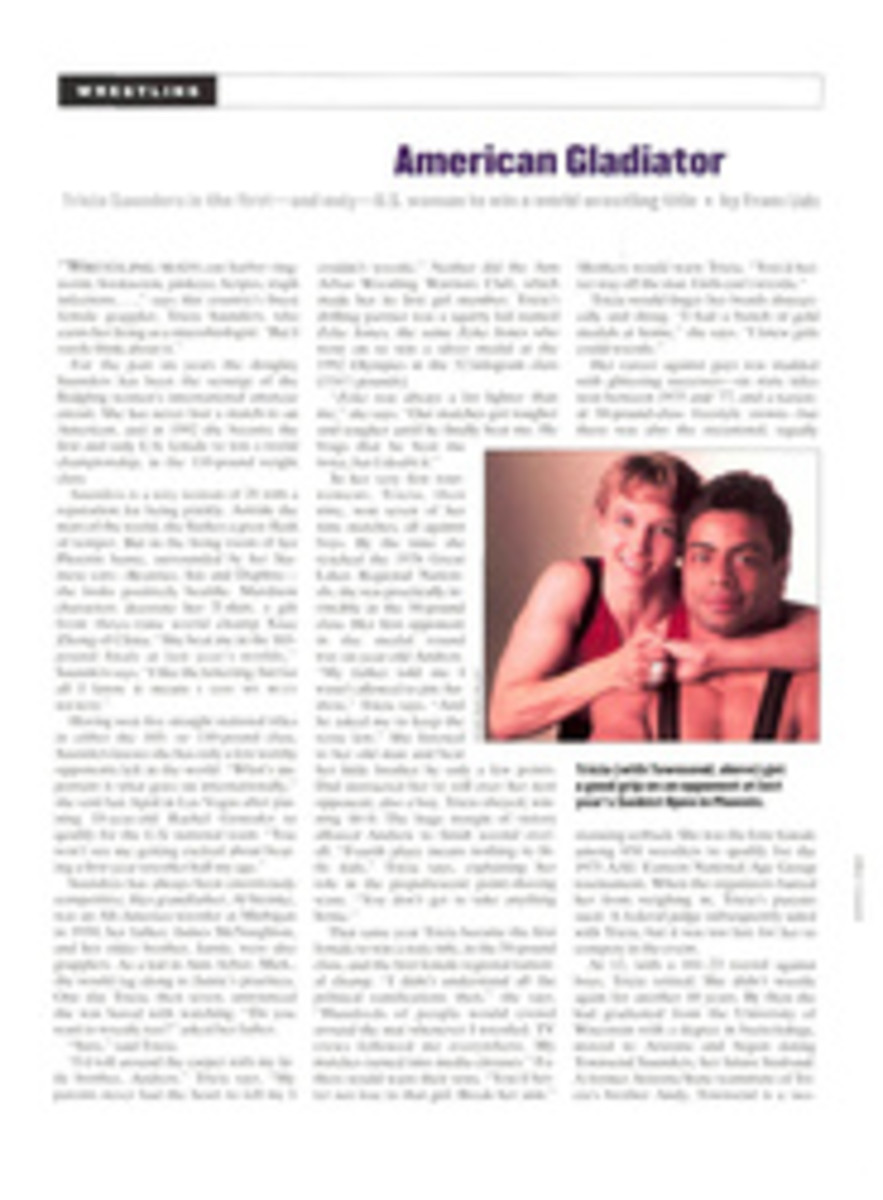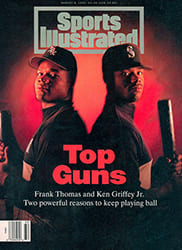
American Gladiator
"Wrestling mats can harbor ringworm, hookworm, pinkeye, herpes, staph infections...," says this country's finest female grappler, Tricia Saunders, who earns her living as a microbiologist. "But I rarely think about it."
For the past six years the doughty Saunders has been the scourge of the fledgling women's international amateur circuit. She has never lost a match to an American, and in 1992 she became the first and only U.S. female to win a world championship, in the 110-pound weight class.
Saunders is a wiry woman of 28 with a reputation for being prickly. Astride the mats of the world, she flashes a great flush of temper. But in the living room of her Phoenix home, surrounded by her Siamese cats—Beatrice, Isis and Daphne—she looks positively beatific. Mandarin characters decorate her T-shirt, a gift from three-time world champ Xiue Zhong of China. "She beat me in the 103-pound finals at last year's worlds," Saunders says. "I like the lettering, but for all I know it means I GOT MY BUTT KICKED."
Having won five straight national titles in either the 103- or 110-pound class, Saunders knows she has only a few worthy opponents left in the world. "What's important is what goes on internationally," she said last April in Las Vegas after pinning 18-year-old Rachel Gonzales to qualify for the U.S. national team. "You won't see me getting excited about beating a first-year wrestler half my age."
Saunders has always been enormously competitive. Her grandfather, Al Steinke, was an All-America wrestler at Michigan in 1930; her father, James McNaughton, and her older brother, Jamie, were also grapplers. As a kid in Ann Arbor, Mich., she would tag along to Jamie's practices. One day Tricia, then seven, announced she was bored with watching. "Do you want to wrestle too?" asked her father.
"Sure," said Tricia.
"I'd roll around the carpet with my little brother, Andrew," Tricia says. "My parents never had the heart to tell me I couldn't wrestle." Neither did the Ann Arbor Wrestling Warriors Club, which made her its first girl member. Tricia's drilling partner was a squirty kid named Zeke Jones, the same Zeke Jones who went on to win a silver medal at the 1992 Olympics in the 52-kilogram class (114½ pounds).
"Zeke was always a lot lighter than me," she says. "Our matches got tougher and tougher until he finally beat me. He brags that he beat me twice, but I doubt it."
In her very first tournament, Tricia, then nine, won seven of her nine matches, all against boys. By the time she reached the 1976 Great Lakes Regional Nationals, she was practically invincible in the 50-pound class. Her first opponent in the medal round was six-year-old Andrew. "My father told me I wasn't allowed to pin Andrew," Tricia says. "And he asked me to keep the score low." She listened to her old man and beat her little brother by only a few points. Dad instructed her to roll over her next opponent, also a boy. Tricia obeyed, winning 10-0. The huge margin of victory allowed Andrew to finish second overall. "Fourth place means nothing to little kids," Tricia says, explaining her role in the prepubescent point-shaving scam. "You don't get to take anything home."
That same year Tricia became the first female to win a state title, in the 50-pound class, and the first female regional national champ. "I didn't understand all the political ramifications then," she says. "Hundreds of people would crowd around the mat whenever I wrestled. TV crews followed me everywhere. My matches turned into media circuses." Fathers would warn their sons, "You'd better not lose to that girl. Break her arm." Mothers would warn Tricia, "You'd better stay off the mat. Girls can't wrestle."
Tricia would finger her braids distractedly and shrug. "I had a bunch of gold medals at home," she says. "I knew girls could wrestle."
Her career against guys was studded with glittering successes—six state titles won between 1975 and '77, and a national 50-pound-class freestyle crown—but there was also the occasional, equally stunning setback. She was the lone female among 850 wrestlers to qualify for the 1975 AAU Eastern National Age Group tournament. When the organizers barred her from weighing in, Tricia's parents sued. A federal judge subsequently sided with Tricia, but it was too late for her to compete in the event.
At 12, with a 181-23 record against boys, Tricia retired. She didn't wrestle again for another 10 years. By then she had graduated from the University of Wisconsin with a degree in bacteriology, moved to Arizona and begun dating Townsend Saunders, her future husband. A former Arizona State teammate of Tricia's brother Andy, Townsend is a two-time Pan-American wrestling champ who finished seventh in the '92 Olympics at 149½ pounds. "It wasn't love at first sight," Tricia says of the man she married in 1992. "At first I thought he was just another meatball wrestler."
While her courtship with the meatball simmered, Saunders resumed her career. Within three years she had beaten Martine Poupon of France, the world's best in the 110-pound class. In the summer of 1990 she flew to Sweden for the first official women's world championships. But with four seconds remaining in her opening match in the 110-pound class, Saunders dislocated a shoulder for the second time in three weeks and had to default. Major surgery followed. "Every doctor told me I was finished with wrestling," Saunders says. "I had to decide if I wrestled because I liked to compete or because I liked to win." She decided she liked to compete.
Saunders slimmed down to 103 pounds for the '91 worlds, in Tokyo. But she had lost too much weight too fast, and she struggled to a fifth-place finish. For the '92 championships, in Villeurbanne, France, Saunders gained back seven pounds. She scored pins in her first two matches in the 110-pound class before facing defending champ Poupon in the semis. Poupon's only loss in three years had been to Saunders, 1-0, four months earlier. This time Saunders shut her down 3-0 and moved into the final against Yoshiko Endo of Japan, a three-time world silver medalist at 117 pounds who had dropped down in weight. Saunders, five inches shorter than the 5'7" Endo, was rolled on her back early on. But she slipped a hold, secured a tiebreaking takedown and went on to win 7-3. Saunders was voted the tournament's best technical wrestler.
So far Saunders has not been able to receive anything near the support that Japanese, Chinese and French women wrestlers take for granted. What the other women have—and what Saunders so conspicuously lacks—is organizational backing funded by the government. In effect, all they have to concentrate on is getting their moves down. Saunders has to hold down a job as well as worry about getting the training that is essential if she's to stand any chance against the rest of the world.
As the lone female on the board of USA Wrestling, the national governing body of U.S. wrestlers, Saunders ferrets out funds to bankroll women's competitions. Though many nations host weekly tournaments, the U.S. has only two a year. "You can't wrestle for glory in the States," Saunders says with a small shrug.
When she won her world title in '92, her French translator exulted, "This will be wonderful! You'll be a hero in America."
Saunders smiled. "No, I won't," she said. "I'll be lucky if I get a ride home from the airport."
She didn't.
PHOTO
PETER READ MILLER
Tricia (with Townsend, above) got a good grip on an opponent at last year's Sunkist Open in Phoenix.
PHOTO
MARSHALL LABOW
[See caption above.]

